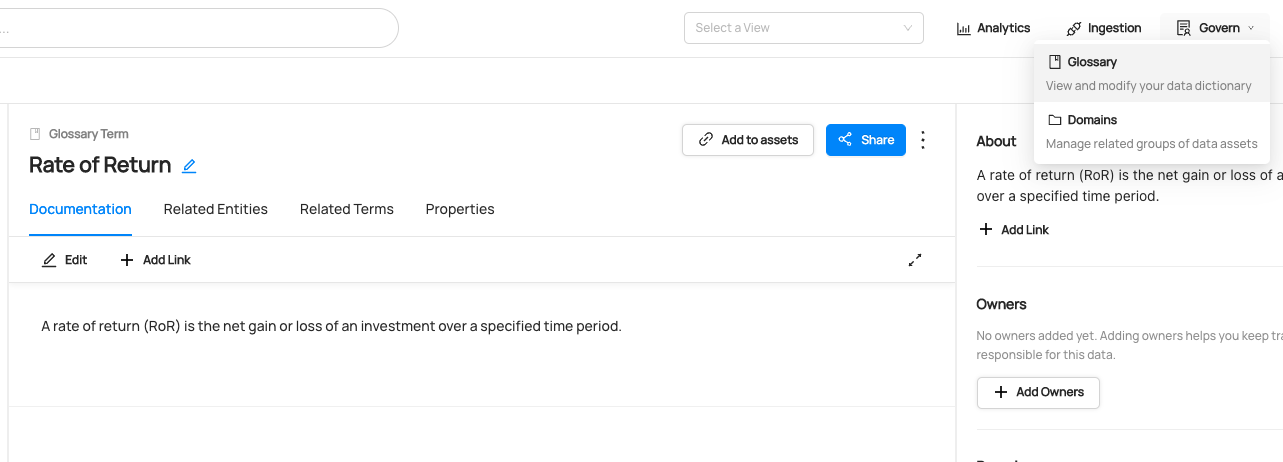Adding Terms On Datasets/Columns
Why Would You Add Terms?
The Business Glossary(Term) feature in DataHub helps you use a shared vocabulary within the orgarnization, by providing a framework for defining a standardized set of data concepts and then associating them with the physical assets that exist within your data ecosystem.
Fore more information about terms, refer to About DataHub Business Glossary.
Goal Of This Guide
This guide will show you how to add a CustomerAccount term to user_name column of a dataset named fct_users_created.
Also, we will cover how to add a term to a dataset itself.
Pre-requisites
For this tutorial, you need to deploy DataHub Quickstart and ingest sample data. For detailed information, please refer to Prepare Local DataHub Environment.
Before adding terms, you need to ensure the targeted dataset and the term are already present in your datahub. If you attempt to manipulate entities that do not exist, your operation will fail. In this guide, we will be using data from a sample ingestion. If you want to know how to create entities using APIs & SDKs, please refer to Creating Terms and Creating Datasets.
Add Terms With GraphQL
Please note that there are two available endpoints (:8000, :9002) to access GraphQL.
For more information about the differences between these endpoints, please refer to DataHub Metadata Service
GraphQL Explorer
GraphQL Explorer is the fastest way to experiment with GraphQL without any dependancies.
Navigate to GraphQL Explorer (http://localhost:9002/api/graphiql) and run the following query.
mutation addTerms {
addTerms(
input: {
termUrns: ["urn:li:glossaryTerm:CustomerAccount"],
resourceUrn: "urn:li:dataset:(urn:li:dataPlatform:hive,fct_users_created,PROD)",
subResourceType:DATASET_FIELD,
subResource:"user_name"})
}
Note that you can also add a term on a dataset if you don't specify subResourceType and subResource.
mutation addTerms {
addTerms(
input: {
termUrns: ["urn:li:glossaryTerm:CustomerAccount"],
resourceUrn: "urn:li:dataset:(urn:li:dataPlatform:hive,fct_users_created,PROD)",
}
)
}
If you see the following response, the operation was successful:
{
"data": {
"addTerms": true
},
"extensions": {}
}
CURL
With CURL, you need to provide tokens. To generate a token, please refer to Generate Access Token.
With accessToken, you can run the following command.
curl --location --request POST 'http://localhost:8080/api/graphql' \
--header 'Authorization: Bearer <my-access-token>' \
--header 'Content-Type: application/json' \
--data-raw '{ "query": "mutation addTerm { addTerms(input: { termUrns: [\"urn:li:glossaryTerm:CustomerAccount\"], resourceUrn: \"urn:li:dataset:(urn:li:dataPlatform:hive,fct_users_created,PROD)\" }) }", "variables":{}}'
Expected Response:
{"data":{"addTerms":true},"extensions":{}}
Add Terms With Python SDK
Following codes add a glossary term named CustomerAccount to a column user_name of a hive dataset named fct_users_created.
You can refer to a full code in dataset_add_column_term.py.
# inlined from metadata-ingestion/examples/library/dataset_add_column_term.py
import logging
import time
from datahub.emitter.mce_builder import make_dataset_urn, make_term_urn
from datahub.emitter.mcp import MetadataChangeProposalWrapper
# read-modify-write requires access to the DataHubGraph (RestEmitter is not enough)
from datahub.ingestion.graph.client import DatahubClientConfig, DataHubGraph
# Imports for metadata model classes
from datahub.metadata.schema_classes import (
AuditStampClass,
EditableSchemaFieldInfoClass,
EditableSchemaMetadataClass,
GlossaryTermAssociationClass,
GlossaryTermsClass,
)
log = logging.getLogger(__name__)
logging.basicConfig(level=logging.INFO)
def get_simple_field_path_from_v2_field_path(field_path: str) -> str:
"""A helper function to extract simple . path notation from the v2 field path"""
if not field_path.startswith("[version=2.0]"):
# not a v2, we assume this is a simple path
return field_path
# this is a v2 field path
tokens = [
t for t in field_path.split(".") if not (t.startswith("[") or t.endswith("]"))
]
return ".".join(tokens)
# Inputs -> the column, dataset and the term to set
column = "user_name"
dataset_urn = make_dataset_urn(platform="hive", name="fct_users_created", env="PROD")
term_to_add = make_term_urn("User")
# First we get the current editable schema metadata
gms_endpoint = "http://localhost:8080"
graph = DataHubGraph(DatahubClientConfig(server=gms_endpoint))
current_editable_schema_metadata = graph.get_aspect(
entity_urn=dataset_urn, aspect_type=EditableSchemaMetadataClass
)
# Some pre-built objects to help all the conditional pathways
now = int(time.time() * 1000) # milliseconds since epoch
current_timestamp = AuditStampClass(time=now, actor="urn:li:corpuser:ingestion")
term_association_to_add = GlossaryTermAssociationClass(urn=term_to_add)
term_aspect_to_set = GlossaryTermsClass(
terms=[term_association_to_add], auditStamp=current_timestamp
)
field_info_to_set = EditableSchemaFieldInfoClass(
fieldPath=column, glossaryTerms=term_aspect_to_set
)
need_write = False
field_match = False
if current_editable_schema_metadata:
for fieldInfo in current_editable_schema_metadata.editableSchemaFieldInfo:
if get_simple_field_path_from_v2_field_path(fieldInfo.fieldPath) == column:
# we have some editable schema metadata for this field
field_match = True
if fieldInfo.glossaryTerms:
if term_to_add not in [x.urn for x in fieldInfo.glossaryTerms.terms]:
# this term is not present
fieldInfo.glossaryTerms.terms.append(term_association_to_add)
need_write = True
else:
fieldInfo.glossaryTerms = term_aspect_to_set
need_write = True
if not field_match:
# this field isn't present in the editable schema metadata aspect, add it
field_info = field_info_to_set
current_editable_schema_metadata.editableSchemaFieldInfo.append(field_info)
need_write = True
else:
# create a brand new editable schema metadata aspect
current_editable_schema_metadata = EditableSchemaMetadataClass(
editableSchemaFieldInfo=[field_info_to_set],
created=current_timestamp,
)
need_write = True
if need_write:
event: MetadataChangeProposalWrapper = MetadataChangeProposalWrapper(
entityUrn=dataset_urn,
aspect=current_editable_schema_metadata,
)
graph.emit(event)
log.info(f"Term {term_to_add} added to column {column} of dataset {dataset_urn}")
else:
log.info(f"Term {term_to_add} already attached to column {column}, omitting write")
We're using the MetdataChangeProposalWrapper to change entities in this example.
For more information about the MetadataChangeProposal, please refer to MetadataChangeProposal & MetadataChangeLog Events
Expected Outcomes
You can now see the term CustomerAccount has been added to user_name column.

